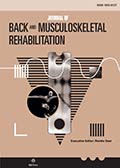Authors: Lippi, Lorenzo | de Sire, Alessandro | Turco, Alessio | Santi, Roberto Mario | Polverelli, Marco | Ammendolia, Antonio | Follenzi, Antonia | Invernizzi, Marco
Article Type:
Review Article
Abstract:
BACKGROUND: Hemophilic arthropathy is a detrimental condition that crucially affects functional outcomes in hemophilic patients. In recent years, due to the advances in systemic therapies, growing attention has been raised in the rehabilitation field in order to improve functional outcomes of hemophilic patients. However, the optimal rehabilitation modalities in these patients are far from being fully characterized. OBJECTIVE: The present study aimed to assess the effects of different rehabilitation interventions on physical functioning and health-related quality of life of hemophilic arthropathic patients. METHODS: The review followed the Preferred Reporting Items for Systematic Reviews and
…Meta-analyses (PRISMA) statement. Five databases were systematically searched for randomized controlled trials (RCTs) published until June 22nd, 2023. The selection criteria included adult patients with hemophilia A and B receiving rehabilitation interventions. The outcomes were muscle strength, physical function, pain intensity, physical performance, and health-related quality of life. RESULTS: Out of 1,743 identified records, 17 studies were included in the qualitative synthesis. Rehabilitation interventions were categorized into exercise intervention, fascial therapy, and multimodal intervention. The findings suggested positive outcomes in terms of muscle modifications, range of motion improvements, joint health enhancements, pain intensity reduction, and quality of life improvements. More in detail, meta-analyses showed significant improvements in pain intensity [ES: - 1.10 cm (- 1.37, - 0.82), p < 0.00001], joint health [ES: - 1.10 (- 1.38, - 0.82), p < 0.00001], In accordance, exercise interventions showed significant benefits in terms of joint health [ES: - 2.54 (- 3.25, - 1.83), p < 0.00001)] and quality of life [ES: 1.17 (0.48, 1.86), p < 0.0000)]. CONCLUSION: Rehabilitation interventions have a positive impact on functional outcomes and health-related quality of life of hemophilic arthropathic patients. Further studies are needed to better elucidate the role of a comprehensive intervention combining different rehabilitation approaches to treat hemophilic arthropathy.
Show more
Keywords: Hemophilia, rehabilitation, fascial therapy, physical exercise, muscle, hemophilic arthropathy
DOI: 10.3233/BMR-230320
Citation: Journal of Back and Musculoskeletal Rehabilitation,
vol. Pre-press, no. Pre-press, pp. 1-18, 2024
Price: EUR 27.50




